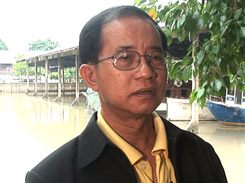

 Every year, our government spends a lot of money on repairing damage caused by natural disasters, especially floods. The sum is increasing every year. This is because in the past, the disaster areas were limited, but now they tend to be widespread, and the duration of the damage tends to be longer, too.
Every year, our government spends a lot of money on repairing damage caused by natural disasters, especially floods. The sum is increasing every year. This is because in the past, the disaster areas were limited, but now they tend to be widespread, and the duration of the damage tends to be longer, too. Satellite images are very useful to us. We can compare this year's situation with images from floods a few years back, and we can find out if certain characteristics of the damage have expanded or diminished. Or maybe, we can even determine why recent floods are more widespread than in the past.
Normally, we use the RADARSAT, because in times of floods the sky is usually overcast. At present, we ask GISTDA for satellite images, and we get them about a week after the flood. We use the satellite images to brief the minister, to understand the scope and boundaries of the flood. In every province, we have regional irrigation offices. So we send the images to them so they can show the governor which parts of the irrigated area, or other areas, are flooded. And the staff of the irrigation office go out and measure the depth of the flooding, so we can calculate how much water is accumulated in which areas. This way we can estimate how many pumps to send to that area and how many days are needed to pump out the water and bring the area back to normal.
Acquiring satellite data is very costly. If Sentinel Asia can provide us with data a few days after the flood event, that would be very useful for us to carry out relief missions. Maybe we'd gain more advantage in terms of disaster prevention if we could get satellite data on a regular basis.